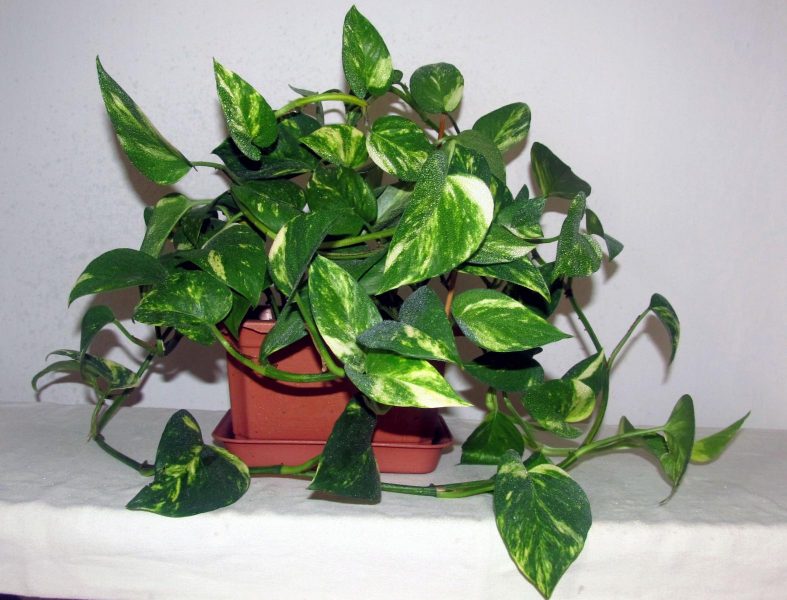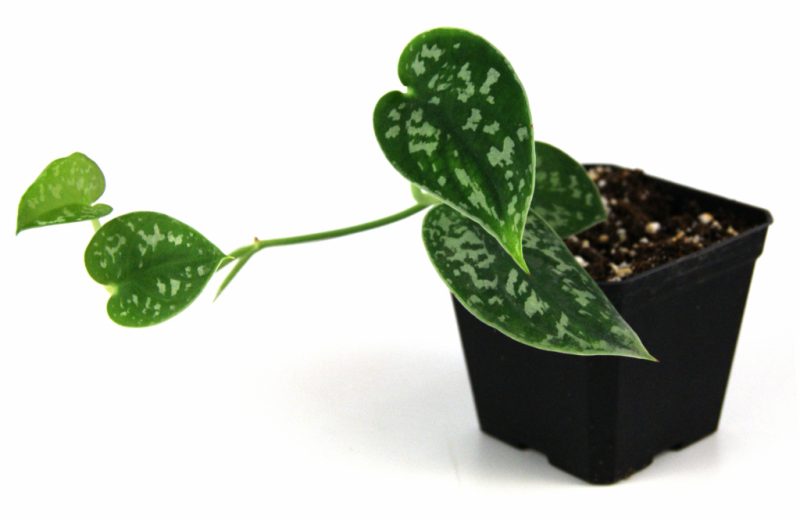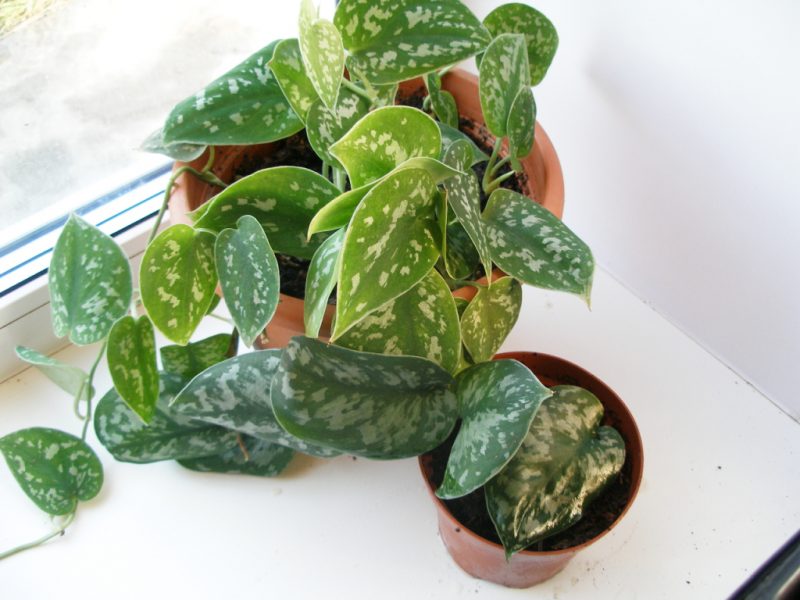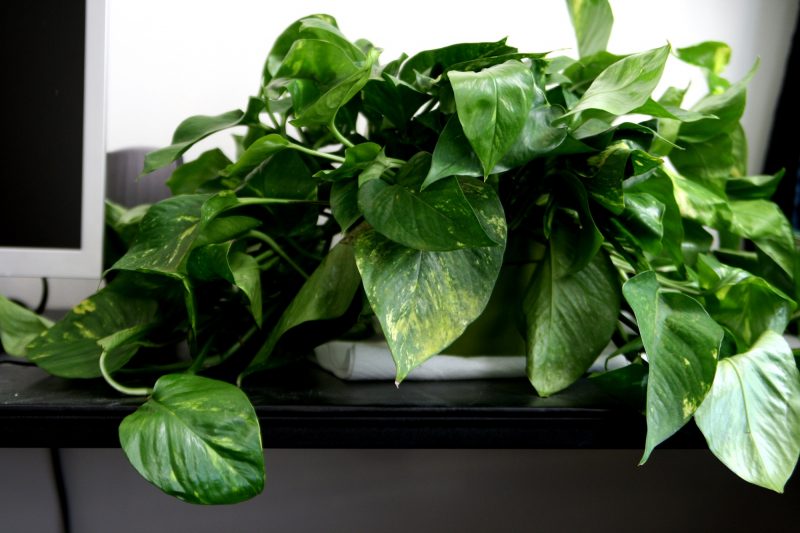Scindapsus is a beautiful tropical liana that flower growers loved for their unpretentiousness in growing. She is most often kept in offices, because she is very tenacious, suffers from poor soil, lack of light and moisture, but does not look very cheerful at the same time. Read how to grow this ornamental plant, transplant and propagate, as well as myths associated with it, in the article.
Material Content:
Scindapsus: species description
This plant belongs to the Aroid family. He leads a semi-epiphytic lifestyle, climbing the trunks of tall trees to the sun. In nature, it is found in tropical Asia, India, Australia, Malaysia, on the islands of the Pacific Ocean (French Polynesia).

Popular indoor types and varieties:
- Golden scindapsus from the islands of the Pacific Ocean. The green leaves of the creeper are covered with characteristic golden spots, for which it got its name. Numerous varieties with different colors have been developed: Neon (lemon-green), Golden Queen (green with yellow-white and lemon spots), Marble Queen (white with green spots);
- Scindapsus painted or a spotted native of Malaysia - a vine with a warty stem and dark green, dense leaves, on which white small spots are visible. Heart shaped leaf plates. A popular variety among gardeners is Agirees (Argyraeus).
- Scindapsus siamese - liana with large asymmetric motley leaves, green-lettuce color.
- Scindapsus Perakensis - different green leaves with a pointed shape.
In nature, the length of the plant can reach 60 meters, it loves warm, moist air.In room conditions, the size of the stem is much more modest, a maximum of 10-15 m.
How to distinguish scindapsus from epipremnum
Many species related to epipremnum were previously considered scindapsuses, these are closely related plants. Very often, and now, these names are used as synonyms for the same indoor flower.

For example, Golden Scindapsus (Scindapsus aureus) or, as it is also called, Golden Epipremnum aureum (Epipremnum aureum) is popular in the culture.
Scindapsus reproduction
Scindapsus is well propagated by cuttings. Root them in soil or water. Not only the apical, but also the middle part of the shoot is suitable for grafting. Even a piece of stem with one bud can be rooted and a young plant is obtained.
Rooted cuttings are well rooted. To do this, put a jar of water or a container with seedlings on a central heating battery.
Home Care
Scindapsus prefers diffused light or slight shading. The exception is variegated varieties, which need bright light to maintain a bright color, but it is better not to put them on the southern windows.

This is an unpretentious plant that loves warm air temperature, it should not be lower than 12 ° C. He does not like dry hot air scindapsus from central heating batteries. With irregular watering, dry spots may form on the plant. He needs high humidity all year round. At 16 ° C, spraying is stopped, watering is reduced.

In summer, plentiful watering is required. Overdrying for a plant is very harmful if it is forgotten to water the plant, it is taken out of the pot, and installed in a tank of warm water. They give it a little dry and again returned to the pot. In winter, it is better to water the scindapsus with hot water, with a temperature of about 50 ° C.
If the plant is poured in winter, the roots rot, the leaves turn yellow and begin to fall. The lashes are trimmed and occupied by the root system. All stalk trimmings are used for cuttings. If the roots have not yet completely disappeared, they are cleaned of the old earth, and planted in fresh soil. After such a transplant, watering is limited, and the plant is monitored, if it starts growing, it means that the rooting was successful.
Read also:streptocarpus: care and cultivation
Fertilize scindapsus from spring, every 10 days, with top dressing for ornamental foliage plants.
The nuances of trimming and crown formation
Scindapsus is a liana, which in room conditions reaches more than 10 meters. It can be grown as an ampel plant. Its stems are weakly branched. With the help of scindapsus, walls are decorated, columns or circular supports are wrapped. It is advisable to plant several cuttings in a pot to get a series of lashes.
You can plant several shoots with different coloring of leaves in a flower pot on a leg, grow not as a vine, but as a hanging ampel bush. When the lashes have reached the desired length, all growth points on them are drowned by trimming, due to this additional tillering occurs. If you put a vase on a column, you can create a beautiful ampelous plant.
How to transplant a plant
The scindapsus flower is unpretentious to the composition of the soil, and grows well even in the soil from the garden. It is transplanted annually into loose, nutritious and moisture-intensive soil. It is useful to transplant young plants 2 times a year. This stimulates their growth, and makes it possible to grow stronger in winter.

The pot needs a close, not more than the volume of the root system. At the bottom, drainage is placed - pebbles or vermiculite, to 1/4 of the landing capacity. Coconut fiber and sphagnum moss are laid on top of the drainage, and ground on top. In the soil for aroid, you can add soil for orchids, this mixture is suitable for many plants. Charcoal and rotted humus can be added to the soil.
When transplanting, the old earth is shaken from the roots. If there are diseased roots, they are removed. Put in a prepared pot with drainage and soil, and fill all the voids with fertile soil.

The transplanted plant is watered with hot water with a temperature of about 50 ° C, sprayed with water on the leaves.
An adult plant, with a developed root system and makings of powerful lashes, is transplanted once every three years.
Pest and Disease Control
With a lack of nutrients in the soil, the leaves of the scindapsus begin to turn yellow. You can save the plant by transplanting into fresh fertile soil and the resumption of monthly top dressing.
Too dry indoor air can cause the tips of the leaves to dry out and cause dry spots to appear on them. To eliminate these symptoms, the plant is watered, the leaves are sprayed, and the level of humidity is increased.

The blanching of the succulent, green leaves of the plant indicates an excess of lighting. Scindapsus rearranged inland, away from the window.
Of the pests, one can most often find a scab, a spider mite and a mealybug. To control the tick use acaricides. The scabbard and mealybug are destroyed by insecticides. It is advisable to collect insects with cotton wool before spraying the plant.
Is it possible to keep a plant at home: signs and superstitions
Many people believe that a liana cannot be kept in a house. It is said that this plant can lead to separation from loved ones and troubles. Should rumors be believed, is it possible to keep scindapsus at home or is it better to leave its cultivation for offices, schools and hospitals? According to the reviews of flower growers, the plant does not have a destructive effect on the life of the owner, that only weak people who do not know who to blame for their troubles can think of a flower as harmful.

Bioenergy, by contrast, believes that this plant can absorb negative energy. If envious people have come to your house, scindapsus will take on all the negative impacts when visiting uninvited guests.
Scindapsus improves mood and improves well-being. If you take good care of it, it allows you to beautifully design a living space, cleans the air in it.












